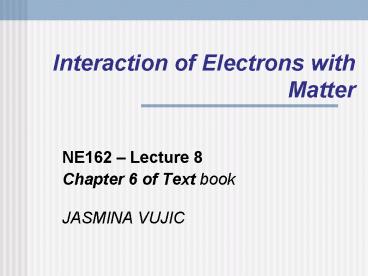Interaction of Electrons with Matter - PowerPoint PPT Presentation
1 / 21
Title:
Interaction of Electrons with Matter
Description:
(c) Could scatter elastically at low energies. Interaction electrons. with matter. http://www.microscopy.ethz.ch/interactions.htm ... – PowerPoint PPT presentation
Number of Views:3657
Avg rating:3.0/5.0
Title: Interaction of Electrons with Matter
1
Interaction of Electrons with Matter
- NE162 Lecture 8
- Chapter 6 of Text book
- JASMINA VUJIC
2
Interaction electrons with matter
- Energy-Loss Mechanisms
- (a) Collisions with electrons
- Ionization of atoms
- Excitation of atoms
- (b) Radiative losses
- Bremsstrahlung
- (c) Could scatter elastically at low energies
3
Interaction electrons with matter
In elastic scattering, the electron trajectory
changes, but its kinetic energy and velocity
remain essentially constant (due to large
differences between the mass of the electron and
nucleus). This process is known as electron
backscattering (although later we will confine
the term "backscattered electrons" to those
scatter out of the sample).
http//www.microscopy.ethz.ch/interactions.htm htt
p//www4.nau.edu/microanalysis/Microprobe/Interact
-Effects.html
4
Interaction electrons with matter
- Inelastic interactions produce diverse effect
including - phonon excitation (heating)
- cathodoluminescence (visible light
fluorescence) - continuum radiation (bremsstrahlung
radiation) - characteristic x-ray radiation
- plasmon production (secondary electrons)
- Auger electron production (ejection of
outer shell electrons) - Most of the energy of an electron beam will
eventually end up heating the sample (phonon
excitation of the atomic lattice)
http//www4.nau.edu/microanalysis/Microprobe/Inter
act-Effects.html
5
Interaction electrons with matter
- Generalized illustration of interaction volumes
for various electron-specimen interactions. - Auger electrons (not shown) emerge from a very
thin region of the sample surface (maximum depth
about 50 Å) than do secondary electrons (50-500
Å).
6
Secondary Electrons
- Energy distribution of secondary electrons (after
Goldstein et al. 1981).
7
Auger Electrons
- Auger-electron emission The hole in the K shell
is filled by an electron from an outer shell
(here L1). - The superfluous energy is transferred to another
electron (here L3) which is subsequently ejected
as Auger electron.
http//www.microscopy.ethz.ch/interactions.htm
8
Interaction electrons with matter
- Due to a small mass of an electron or positron
- They can transfer large fraction of their energy
in a single collision - Can rapidly change their direction after a
collision - Rather than Range (difficult to define), keep in
mind their pathway - After loosing their kinetic energy, positrons
will annihilate with electrons and produce 2
gamma rays.
9
Emission of continuous X-rays (Bremsstrahlung)
- In addition to loosing its energy in collisions
with the atomic electrons, causing ionization or
excitation of the atoms along its path, a charged
particle (in our case an electron) gives up its
kinetic energy by a photon emission as it is
deflected (or accelerated) in the EM field of
nuclei. - The emitted EM radiation has a continuous energy
spectrum from 0 to Ek, where Ek is the kinetic
energy of a charged particle. - For Ek lt 100 keV, radiation is emitted at 90 to
the direction of the charged particle. For higher
Ek the direction of the emitted radiation becomes
forward-peaked.
10
Electron Interactions
- Comparison of electron paths (top) and sites of
X-ray excitation (bottom) in targets of aluminum,
copper, and gold at 20 keV, simulated in a Monte
Carlo procedure (after Heinrich, 1981)
11
STOPPING POWER
- The stopping power is defined as the kinetic
energy loss by an electron or positron per unit
path length due to collisions or emitted
radiation
12
STOPPING POWER
- For monoenergetic electrons with the kinetic
energy Ek,o incident on a thick target, the
energy emitted as radiation per electron is
13
RADIATION YIELD
- The yield is defined as
- and represents only 1-2 of total energy
deposited for low electron energies.
14
(No Transcript)
15
Electron Range
- A theoretical expression for the "range" of an
electron, the straight line distance between
where an electron enters and its final resting
place, for a given Eo is (Kanaya Okayama, 1972)
http//www4.nau.edu/microanalysis/Microprobe/Inter
act-Volume.html
16
Electron Tracks
- Track (2D)
- 5 keV e- in H20
17
Cross Sections
- Total cross sections of interaction (e-)/H2O
18
RANGE
- The following are empirical equations for
electrons in low-Z materials
19
Interaction of low-energy electrons with water
- The end product of any form of ionizing radiation
is a spatial distribution of low-energy secondary
electrons - In average, it takes only about 22 eV to produce
a secondary electron in liquid water, thus
creating a large number of secondary electrons - At low energies, radiative loss of energy is
negligible - Low-energy electrons loose energy mostly by
ionization of atoms.
20
Interaction of higher-energy electrons with
materials
- What fraction of the energy of a 2-MeV beta ray
is converted into bremsstrahlung when the
particle is absorbed in aluminum and in lead - For Al, ZT 13 x 2 26, Y (Al) 0.016 (or 1.6
will be converted in EM) - For Pb, (Z82), Y 0.09 (or 9 will be converted
in EM)
21
Restricted Stopping Power
- (-dE/dx) is the energy lost by a charged particle
per unit path length - (-dE/dx)delta includes only those collisions in
the energy transfer is less then delta E. - This restricts the range of secondary electrons.
- Linear energy transfer LET (-dE/dx)delta

